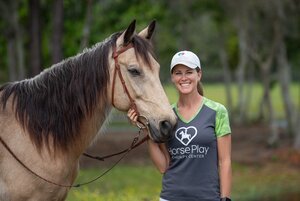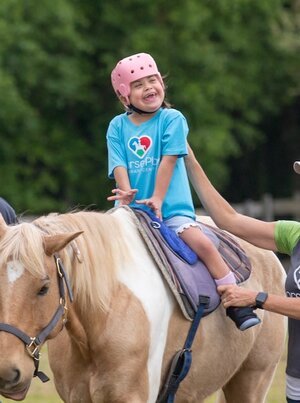HorsePlay Therapy: Where Horsin’ around is Encouraged
By Monika Bernthal
When Vicky Carregal was 16 years old she got on a horse for the first time and was promptly thrown off. She walked away uninjured but easily came to terms with the fact that she would never be an equestrian.
Her dreams as a jockey dashed (not!), she went to college to follow her true calling of becoming a physical therapist to help children with special needs. Vicky had been working as a physical therapist at a clinic for 12 years when the mother of one of her patients asked her about hippotherapy.
Her daughter, Allison, had become Vicky’s patient when she was only 4 months old after being diagnosed with a genetic condition that significantly delayed her development. When Allison turned two, her mom asked Vicky whether she had ever used horse therapy. While Vicky was familiar with this therapy that uses horseback riding as a therapeutic or rehabilitative treatment, she had never used this method to treat a patient.
As Vicky learned more about the effectiveness of hippotherapy - as well as the fact that this form of treatment was not readily available to so many of her patients who would benefit - she decided to quite literally, get back on the horse. Not only did she learn to ride, she also obtained specialized training that would enable her to provide her patients the best therapy.
When Vicky began providing hippotherapy in 2013 to Allison as well as other patients, she quickly discovered that the kids were progressing twice as fast with horse therapy than through traditional means alone. Within months of treating Allison, the two year old was now accomplishing tasks they had been working on for more than a year in traditional sessions. Allison was now siting by herself and eventually began crawling on her own. Fast forward one year into hippotherapy, and Allison spoke her first word, “Mom!” at the age of three.
However, renting stables and borrowing horses was not a sustainable means to provide this treatment Vicky wanted to make readily available to hundreds of kids who would benefit. Therefore, in 2015 she created the St. Augustine-based nonprofit we now know as HorsePlay Therapy Center. Since its inception, Horseplay Therapy has been providing physical therapy, occupational therapy and speech therapy on horseback to children with special needs.
Their innovative therapy for children consists of equine-assisted physical, occupational and speech therapies, followed by time spent off the horse in a more traditional environment. It is the blending of therapies on and off the horse that produces the greatest outcome for each child.
Let’s dig a little deeper into exactly how horse therapy works. Essentially, horses help the patients with sensory input and movement. Patients use no reins, no saddle, no stirrups. Every session is conducted bareback.
For kids who are unable to walk (because a horse’s gait is very similar to that of a human) the kids are able to feel the motion of walking and become used to it. Sitting on the horse requires the patient to have the same posture as if they were walking. This strengthens their core and begins to develop the strength they need to walk on their own one day. In this way, the physical therapy is highly effective.
Walking the horse is also effective for working with those children who are on the spectrum. The sensory input derived from the horse’s rhythmic movement creates a pattern and soothes the patient who might otherwise be overwhelmed by stimuli. By adapting the child to the stimulus in a controlled manner, they begin to adapt to an increased amount of stimuli they can handle and ultimately transfer this sensory control to the classroom and other parts of their life.
Hippotherapy has also been proven extraordinarily useful to non-verbal patients - because who wants to sit on a horse that doesn’t move? The kids learn that when they are vocal with the horse, the horse will react in a positive way. They are conditioning kids to make noises or speak – which is simultaneously strengthening their vocal chords to allow for more vocal production. Plus, the act of sitting on the horse continues to strengthen their core.
But the therapy goes beyond speech and walking. Sometimes, a child will simply sit on a horse to do a puzzle. The horse serves purely as the modality. Kids love being outside and this prevents therapists from having to chase a patient across the room – but gives them a focused child with whom to work.
It’s also often the case that a child is more likely to connect with an animal than a human. While the patient may be unwilling to speak to people, the kids might have a full conversation with their horse. These interactions then slowly transition to social interaction.
Of course, these are no ordinary horses. While they may be common breeds, such as a Tennessee Walker, Welsh Pony, Quarter Horse, or Rocky Mountain Walking Horse… these therapy horses have been specially trained to be desensitized. The therapy horses won’t react to noises, sudden movements – even kicking and screaming. Meanwhile the horses are used in a number of ways as kids may stand on the horse, sit on a stationary horse for 30 minutes straight or even ride backwards.
A typical hippotherapy session is 30 minutes and involves the horse that has been specifically chosen for the child, a physical therapist, a horse handler and a side-walker. The kids range in age from 2 to 16, with the majority of the patients falling in the 2-11 range. Today, HorsePlay Therapy provides more than 600 therapy sessions per month as a part of a children’s speech, occupational or physical therapy treatment plans.
Moving forward, HorsePlay Therapy hopes to begin offering summer camps in the summer of 2021. They also have plans to implement a new program, “Rise Up” for veterans suffering from PTSD.
Unfortunately, hippotherapy is not cheap. While most insurance companies will cover the cost of the actual session as physical therapy, there are fees associated with the horse itself… the feed, vet bills, training and the list goes on. Therefore, HorsePlay charges a small fee for the use of the horse. However, they never deny a child hippotherapy, and therefore provide scholarships and often cover this cost.
As a result, HorsePlay relies heavily on the support and generosity of local individuals and businesses including Southeast Veterinary Clinic and Ancient City Medical Billing Services, who are doing their part to support HorsePlay through donations or sponsoring a child for a year. In September 2019, country music star Kacey Musgraves donated the proceeds from her Sing Out Loud performance to the nonprofit enabling them to erect a covered arena so that hippotherapy can be provided year-round.
Because Vicky and her team know that so many can benefit from hippotherapy, HorsePlay Therapy works tirelessly to increase awareness for this type treatment and expand their programs to help even more individuals (such as veterans).
Visit horseplaytherapy.org to learn more about the services HorsePlay Therapy Center provides as well as their plans for the future.



